In the fascinating realm of gemstones, there exists a captivating marvel known as the agate stone.
Heralding from the fiery crucibles of ancient volcanic eruptions, agate stone has journeyed through time, bearing the testament of epochs in its uniquely exquisite bands. As vibrant and diverse as a painter’s palette, agate stone possesses an allure that captivates the eye and enchants the soul.
From the ancient river Achates where it was first discovered to contemporary artisans’ workshops, the agate stone’s appeal remains timeless and universal.
Its swirling patterns narrate tales of geologic transformation while resonating with human emotions and aspirations. It’s more than just a stone; it’s a cosmic masterpiece, a slice of the universe’s creativity encased within tangible, earthly bounds.
Welcome to the mesmerizing world of agate stone, where every band has a story, every hue has a voice, and every stone is a testament to the earth’s enduring beauty.
What is Agate Stone?
Agate stone, treasured as a natural work of art, is a variety of chalcedony, a cryptocrystalline form of quartz. Over millions of years, this captivating gemstone forms in concentric layers in a wide array of colors and textures, resulting from countless centuries of change in temperature, pressure, and mineral content.
What sets agate apart from other gemstones is its stunning, swirling patterns, and vibrant colors, spanning from the deepest blues to the most radiant reds.
These colors and patterns manifest in myriad forms and hues, resulting in an agate stone for every aesthetic taste. The patterns in agate stones can be solid, speckled, mottled, or multi-colored, with decorative bands or unique inclusions.
The distinctive bands that ripple across the surface of agate stones are a record of its geological story. The bands form slowly over time, creating a sequence of layered beauty, akin to the rings of a tree.
The unique features of agate stone don’t stop at its exterior. Under the surface, agate can hold fossilized remains, creating fascinating scenes from an epoch long past.
Agate’s unique properties and captivating beauty make it a popular choice for jewelers and gemstone collectors alike. Jewelry made from agate is appreciated for its unique artistic patterns and excellent durability. What’s more, is that it’s accessible and affordable for most jewelry enthusiasts.
Besides jewelry, agate is also used for decorative items such as bookends and coasters, as it can be sliced thinly while preserving its color and structure. It’s distinctive patterns and vibrant colors also make it a favorite material in the concise arts.
No matter how it is used, agate continues to fascinate by offering a visual feast with its swirling colors and patterns, which are proof of nature’s art. It is a jewel that bridges the gap between the turbulent past of the world and the beauty it offers us today.

Types of Agate Stones
There are numerous types of agate stones, each with its own unique colors and patterns. Some of the most well-known types include:
- Blue Lace Agate: Known for its delicate, lacy blue and white bands.
- Moss Agate: Characterized by its green mineral inclusions that resemble moss.
- Fire Agate: Showcases iridescent flashes of red, gold, and green, similar to opal.
- Crazy Lace Agate: Offers intricate, lace-like patterns in a variety of colors.
- Dendritic Agate: This variety contains branch-like inclusions, often in black or brown.
- Botswana Agate: Features bands of white, pink, salmon, or peach, and is named after the region in Africa where it is primarily found.
- Tree Agate: Like moss agate, this variety includes green inclusions, but they often branch out, resembling trees.
- Indian Agate: Known for its green, brown, red, and blue colors, it’s mainly found in India.
- Sardonyx: A variety of agate that includes layers of sard, which is a brownish-red variety of chalcedony.
- Laguna Agate: Renowned for its vibrant colors and tight banding, primarily found in Mexico.
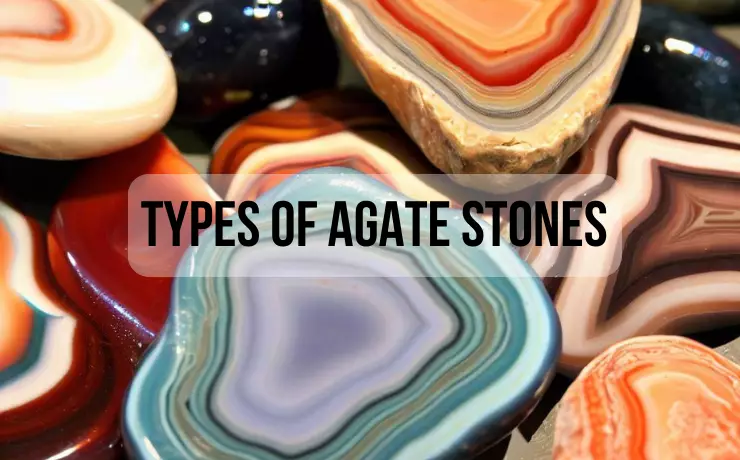
Colors of Agate Stone
Agate stones come in virtually every color of the rainbow, thanks to the impurities present during their formation. Here are some of the most common colors:
- Blue: Seen in blue lace agate and Holley blue agate.
- Green: Found in moss agate and tree agate.
- Red, Orange, and Brown: Common in fire agate and carnelian agate.
- White and Gray: These neutral tones are prevalent in many types of agate.
- Black: Often seen in onyx, which is a variety of agate.
- Pink and Purple: Although less common, some agates, like Botswana agate, can have pink bands. Purple agates are often dyed to achieve their color.
- Multicolored: Many agates, like crazy lace agate and rainbow agate, exhibit multiple colors.
Each color and type of agate carries its own specific meaning and uses in crystal healing, jewelry making, and home décor. No matter the type or color, every agate stone carries with it a unique beauty that sets it apart.
Agate Stone History
Agate stones have a rich history dating back to ancient times. Agate is named after the Greek philosopher Theophrastus, who discovered it on the banks of the Achates River.
Agate stones continue to be discovered in archaeological sites around the world, from Egypt to Greece, revealing that it has been an important stone for humanity through the ages.
How Agate is Formed?
The formation of agate stone is a process that spans millions of years. It begins with volcanic eruptions that produce silica-rich lava. As the lava cools and hardens, cavities are formed within the rock. Over time, layers of silica are deposited into these cavities, eventually solidifying into what we recognize as agate stone. The unique bands of agate form as the stone slowly grows from the cavity wall inwards.
Agate Stone Meaning
The profound meaning of agate stone is deeply entwined with notions of balance, stability, and grounding. In the turbulent ebb and flow of life, agate serves as an anchoring touchstone, harmonizing the energies around and within us.
Known for its balancing properties, agate is often employed in crystal healing to equalize and stabilize yin and yang, the positive and negative forces that hold the universe in cohesion. It fosters emotional, physical, and intellectual balance, helping to center the being and encourage self-examination.
As a grounding stone, agate plays a significant role in spiritual practices. It anchors the spirit, providing a calm tranquility that supports quiet introspection and pragmatic problem-solving.
The grounding effect of agate also makes it an excellent stone for meditation, facilitating a connection with the earth and one’s deeper self.
In tandem with its grounding properties, agate imbues its holder with a sense of calm and serenity, a peaceful sanctuary amidst the storms of life. It’s known to dispel fear, anxiety, and stress, instilling a deep sense of security and safety.
Agate’s vibrant colors and intricate bands serve as a visual metaphor for its inherent meaning.
Just as each band harmoniously weaves together to form the whole, agate is believed to facilitate harmonious energy flow in individuals and environments.
Its colors, whether soothing blues, energizing reds, or harmonizing greens, resonate with different energy centers in the body and are thought to evoke specific emotional states and healing properties.
Additionally, agate is also associated with truth and courage. It’s thought to enhance mental function, improve concentration, enhance perception, and stimulate analytical capabilities.
This makes agate a useful talisman for anyone needing to solve complex problems or seeking to discover the truth.
In essence, the agate stone is a symbol of the earth’s inherent balance and stability. Its meaning is a reminder of our capacity for emotional resilience, intellectual growth, and spiritual grounding. Each agate stone, with its vibrant colors and intricate bands, is a celebration of equilibrium, inviting us to tap into its tranquility, balance, and grounding energy.
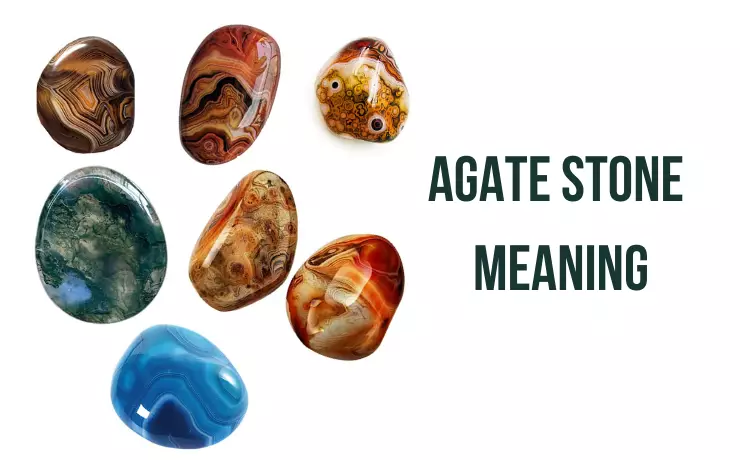
Agate Healing Properties
Long revered as a powerful healing gemstone, agate stone possesses an array of properties that holistically enhance wellness and harmony. Its therapeutic influence extends across the mental, emotional, and physical realms, presenting a comprehensive approach to well-being.
On a mental level, agate is renowned for enhancing mental function. It’s thought to aid in stimulating and strengthening analytical capabilities, thus encouraging clarity of thought and increased concentration.
Beyond mental stimulation, agate also offers a calming effect on the mind and suppresses restlessness, and drives away negative thoughts. It also clears the mind, facilitating a mental environment conducive to peace, focus, and positive thinking.
Its energy is thought to remove emotional tension, induce tranquility, and promote emotional stability.
Many use agate to alleviate feelings of restlessness and facilitate the release of emotional toxicity, thus inviting a sense of peace and tranquility into their lives.
Physically, agate stone is believed to have a stabilizing effect on the body. Some practitioners of crystal healing use it to maintain or improve physical balance and to strengthen the body’s connection to the earth.
It is also sometimes used in an attempt to reduce symptoms of certain physical ailments, such as headaches, digestive issues, or skin problems.
In the world of crystal healing, agate is often employed as a supportive tool to promote sleep and dreams. It’s thought to provide protective energy that wards off nightmares while also encouraging pleasant dreams and restful sleep.
While the healing properties of agate stone are widely revered, it’s important to remember that these benefits are not medically verified. Agate stone and other crystals should be used as complementary tools alongside traditional medical treatment and not as substitutes.
👉 Get Agate Stone for your health!
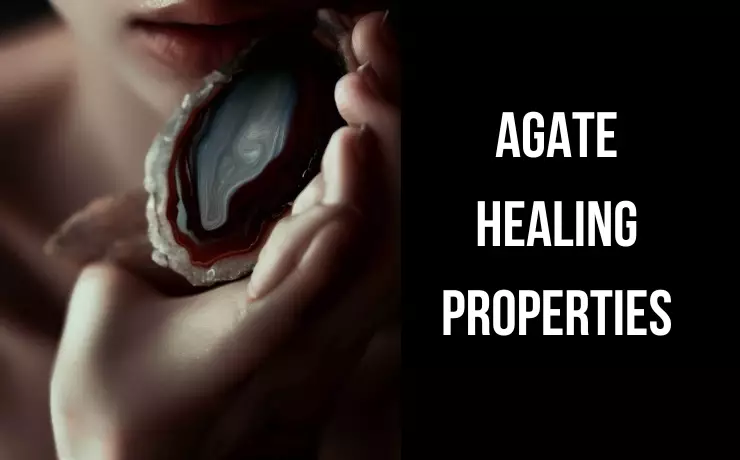
Metaphysical Properties of Agate Stone
Metaphysically, agate stone is associated with protective energy. It’s believed to shield its wearer from negative energies and promote emotional, physical, and intellectual balance. Some crystal healers also use agate for its supposed ability to enhance self-confidence and stimulate self-analysis.
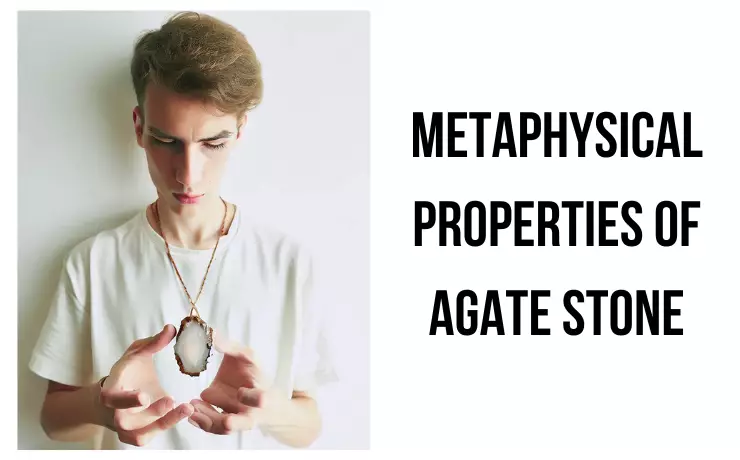
How to Tell If an Agate Stone is Real
Discerning the authenticity of an agate stone calls for a careful examination of its physical and visual characteristics. Unlike synthetic or imitation stones, real agate possesses a set of defining traits that contribute to its unique allure.
Firstly, real agate is distinguished by its semi-transparency to translucency. This means that when held up against a light source, it should allow some light to pass through it. If the stone is opaque or allows a substantial amount of light to pass through, it may not be a genuine agate.
The hallmark feature of real agate is its characteristic banding pattern. These bands, which are usually concentric and parallel, can be multicolored and display a range of patterns.
They might be straight, curved, or swirling, but they are typically well-defined and distinguishable when held against the light. The banding is the result of agate’s slow formation process and is not usually found in synthetic or imitation stones.
One should also pay attention to the surface of the stone. Genuine agate has a smooth, almost waxy luster. This differs significantly from glass or plastic imitations, which might look shiny or glossy but lack the distinct feel of agate.
It’s worth noting that the weight of agate can also be indicative of its authenticity. Agate is denser than most imitation stones, so it should feel relatively heavy for its size when held in the hand.
Finally, consider the price and the seller. Real agate is pretty affordable, but if the price seems too good to be true, it may not be. Always purchase from reputable vendors who are knowledgeable about gemstones and have positive reviews.
However, please remember that while these tips can help you make an educated guess about a stone’s authenticity, only a certified gemologist can definitively confirm if an agate stone is real.
If you are investing a significant amount of money in purchasing agate stones, consider seeking professional advice to ensure your investment is genuine.
Agate Stone Cleaning and Care
Agate stone, although a sturdy gemstone, requires careful attention to retain its luster and vibrancy. The cleaning process is simple and does not demand any specialized equipment.
For general cleaning, mild soap and warm water are the go-to solutions. Simply submerge the stone in soapy water and gently clean the surface using a soft cloth or a soft-bristled toothbrush. This gentle cleaning helps remove dirt, dust, and oils that may have accumulated on the stone.
Rinsing is an important step post-cleaning. Ensure the agate is rinsed thoroughly under warm running water to remove any soap residue, which can dull the stone’s luster over time if left unchecked.
Following the rinse, it’s vital to dry the agate stone thoroughly. Moisture left on the stone can lead to damage over time. Pat the stone dry with a soft cloth and allow it to air dry completely before storing or wearing.
Avoid exposing agate to harsh chemicals, high heat, or direct sunlight for extended periods, as these can damage the stone’s color and structure. When storing agate, wrap it in a soft cloth or keep it in a fabric-lined jewelry box to prevent scratches.
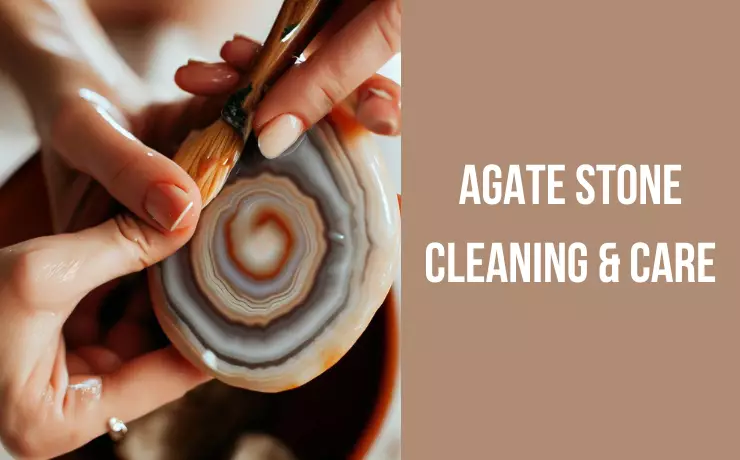
How to Polish Agate Stones at Home?
Polishing agate stones at home can transform a rough agate into a gleaming gem. This process requires patience, but the result can be highly rewarding.
You’ll need a series of sandpapers with different grit sizes, ranging from coarse (around 80 grit) to fine (up to 3000 grit). Start with the coarsest sandpaper to remove any impurities or rough patches on the agate’s surface.
Hold the stone under running water while you sand it to prevent dust from forming. Rub the agate against the sandpaper using circular motions, ensuring all parts of the stone get evenly sanded.
Once you’ve thoroughly sanded the stone with the coarse sandpaper, progress to the next grit size. Repeat the sanding process with each grit size, always moving from coarse to fine. This gradual progression helps remove scratches from the previous grit and smooths the stone’s surface.
After using the finest grit, the agate should have a noticeable shine. To enhance this shine, you can apply a polishing compound like cerium oxide and buff the stone with a soft cloth.
Remember to wear safety glasses and a dust mask during the polishing process to protect yourself from tiny rock particles that may be released. It’s also important to note that polishing agate stones requires time and patience, but seeing the stone’s transformation makes it worthwhile.
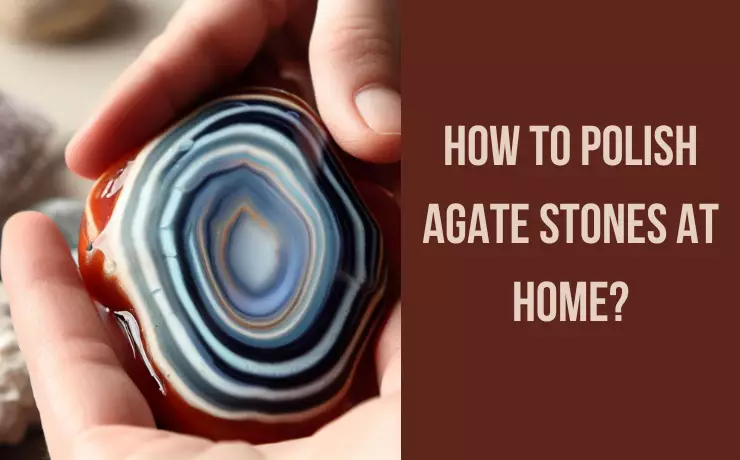
Agate Stone Usage Areas
The captivating appeal of agate stones has rendered them highly versatile, finding use in various domains, from home decor to intricate jewelry.
Decorative pieces made from agate are a popular choice for those seeking to bring a touch of nature’s art into their living spaces.
Polished agate slices, showcasing the stone’s stunning bands and colors, make eye-catching display pieces. They’re often used as coasters, paperweights, or standalone decorative items.
Apart from standalone pieces, agate is also integrated into home decor elements. Embedded in furniture, framed as wall art, or used in crafting exquisite lampshades, agate’s vibrant patterns add a unique flair to interior designs.
In the world of jewelry, agate stones hold a place of prominence. Their range of colors and unique banding patterns are skillfully utilized in crafting necklaces, bracelets, earrings, and rings.
Whether as the centerpiece of a statement necklace or as a delicate charm on a bracelet, agate adds an earthy elegance to jewelry designs.
Beyond decorative items and jewelry, agate stones are also used in crafting musical instruments, especially percussive ones like maracas and rainsticks. The hardness and density of agate contribute to the unique sound these instruments produce.
👉 Check out the perfect Agate bookmarks!
👉 Check out the impressive Agate bookmarks!
👉 Gift Agate coasters to your loved ones!
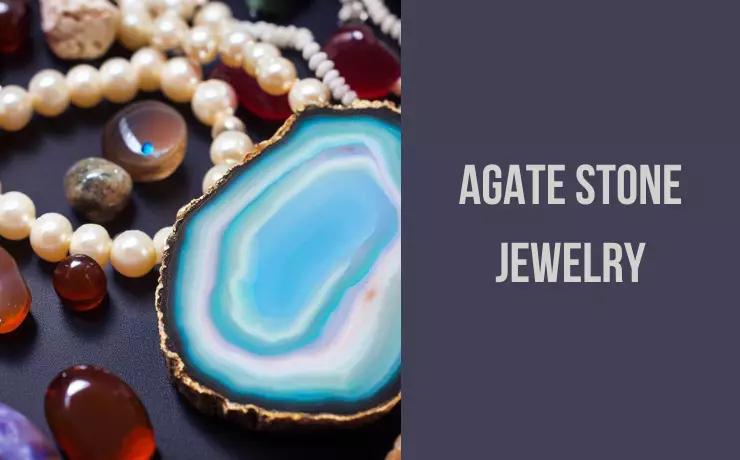
Agate Gems
Agate gems, with their stunning array of forms, colors, and patterns, are a gem enthusiast’s delight. They are available as cabochons, beads, and freeform shapes, each offering a different aesthetic appeal.
Cabochons are polished, non-faceted gems, typically in oval or round shapes. Agate cabochons, with their smooth domes showcasing the stone’s intricate banding, are often used in pendants, brooches, and large statement rings.
Agate beads are another popular form. Their vibrant colors and unique patterns add an earthy charm to bead jewelry. They’re perfect for crafting necklaces, bracelets, and anklets. Agate beads are also used in creating mala beads for meditation practices.
Freeform agate gems are pieces that retain their natural shape, only polished to bring out the stone’s colors and patterns. These unique pieces are often used in jewelry that highlights the natural beauty and uniqueness of the stone.
Despite the form, agate gems impart a touch of natural elegance to any piece they adorn. Whether set into precious metals or strung into beaded jewelry, agate gems never fail to mesmerize with their earthy allure.
Agate Stone FAQ
Let’s answer some questions you may have about this fascinating gemstone.
What is the hardness of Agate Stone?
Agate, like other forms of chalcedony, rates about a 7 on the Mohs hardness scale, making it relatively durable and resistant to scratches.
How can I use Agate Stone for Healing?
In crystal healing, agate is often used for its soothing and grounding properties. You can wear it as jewelry, keep it in your living spaces, or meditate with it.
What is the most valuable color of Agate?
While all agate stones possess their own unique beauty, blue lace agate is often considered more valuable due to its delicate blue color and intricate lace-like patterns.
How should I store my Agate Jewelry?
To maintain the integrity and color of your agate jewelry, store it in a cool, dry place away from direct sunlight. It’s also a good idea to keep it separate from other gemstones to avoid scratches.
How can I tell if my agate stone is dyed?
Natural agate comes in a wide variety of colors, but some stones on the market are artificially dyed to enhance their appearance. If the color of the stone is extremely bright or uniform, or if there are concentrations of color around cracks and fractures, it may be dyed.
Can agate stones be used outdoors?
Yes, agate stones can be used outdoors, but they should be protected from harsh weather conditions to prevent damage. They are often used in garden decorations, but it’s recommended to bring them inside during winter to prevent any potential damage from freezing temperatures.
Are all agate stones banded?
One of the key characteristics of agate stones is their beautiful banding. However, not all agates have visible banding. Some types, like moss agate and plume agate, have dendritic (tree-like) inclusions or plume-like features instead.
Is agate suitable for everyday jewelry?
Yes, agate is a good choice for everyday jewelry. With a hardness of 6.5 to 7 on the Mohs scale, it is resistant to scratches and durable enough for regular wear. However, as with all gemstone jewelry, care should be taken to avoid harsh impacts and exposure to harsh chemicals.
Can I find agate stones near my location?
Agate stones are found all over the world, including in the United States, India, Morocco, Brazil, and Australia. However, the availability of agate stones in your specific location would depend on the local geology. Check with local gemstone or rock-hunting groups for specific information about your area.
What is the most valuable type of agate?
The value of an agate can depend on several factors including size, quality of banding, uniqueness of patterns, and overall condition. Certain types, such as Blue Lace Agate, Fire Agate, and Botswana Agate are particularly valued by collectors and jewelry designers.
Gemstone Library
How to heal chakras with crystals?
Healing properties of Emerald gemstone
Get to know RUBY gemstone benefits
Spiritual benefits of wearing diamond
Bloodstone Heliotrope Gemstone
Aventurine properties and uses
Spiritual Library Online
How long does it take to learn kundalini yoga?
How to create a new age atmosphere?
Solve your problems through meditation
Difference Between Karma and Karmic
Buddha Quotes on Karma in English
Money Numbers in Numerology and Crystals
Deep Spiritual Meaning of Mirrored Numbers
What does triple numbers mean spiritually?

